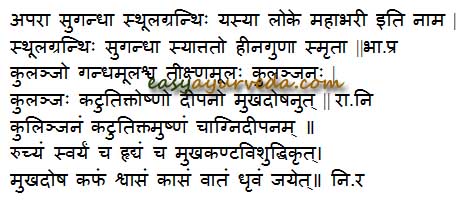Alpinia galanga (Thai Ginger) Uses, Research, Remedies, Side Effects
Mahabhari Vacha – Alpinia galanga is an Ayurvedic herb used for the treatment of sore throat, erectile dysfunction, cough, common cold, oral freshness and increased urination.
Latin name- Alpinia galanga wild.
Family- Zingiberaceae (Ardraka kula)
Table of Contents
Uses
Uses of Greater Galangal as per Ayurveda:
It is similar to Vacha – Acorus calamus in qualities. But it is slightly less potent than Vacha.
Ruchya – improves taste, relieves anorexia.
Deepana – improves digestion strength
Svarya – improves voice tone and quality
Hrudya – acts as cardiac tonic, congenial for heart
Mukha Vishuddhikrut – cleanses oral cavity
Kanthavishuddhi krut – cleanses throat
Indications
Indicated in
Shwasa – asthma and chronic respiratory disorders
Kasa – cough, cold
Vataroga – Vata Dosha imbalance disorders such as neuralgia, paralysis, constipation, bloating, etc.
Folklore Uses
In convulsion – chew the corns and apply to head
Food poisoning– Rhizome is crushed and used internally
Bronchial catarrh – kwatha – herbal decoction of rhizome is used.
It is used in respiratory troubles in children
Rhizome is carminative and stomachic
Effective in sore throat and hoarseness of voice
Cough, throat infection, asthma, impotency, coryza, catarrhal affection nervine disorders abdominal colic, anorexia, vata vyadhi, urinary, ailments, mouth foul, excess colds
Indigestion – dry powder of rhizome is administered orally.
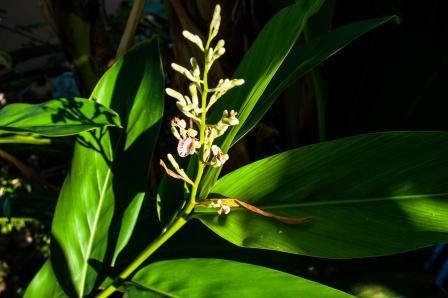
On external use: –
It acts as stimulant it is rubbed on the body to treat hypothermia, to relieve excess perspiration and pain.
Side effects
Side Effects Of Greater Galangal:
The herb is a nerve stimulant and slightly increases the blood pressure and flow; hence people suffering from hypertension should use this herb with caution.
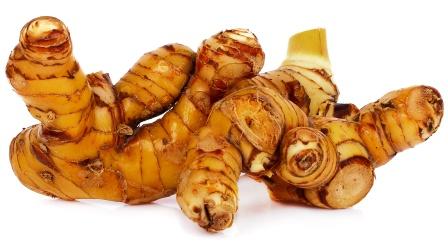
Habitat:
The plant belongs basically to Java, Indonesia and is available throughout South East India. In South India, the herb ‘Rasna’ is used for Alpinia galanga.
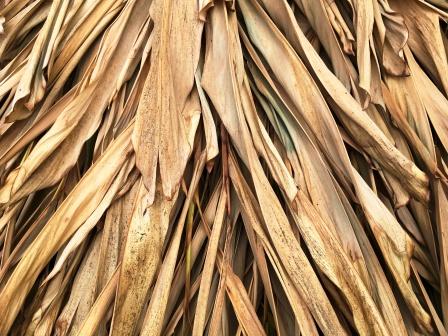
Properties, part used, dosage
Properties:
Rasa (Taste) – Katu (Pungent)
Guna (Qualities) – Laghu (Light for digestion), Teekshna (Strong), Ruksha (Dry in nature)
Vipaka – Katu (Undergoes Pungent taste after digestion)
Veerya (Potency) – Ushna (Hot)
Karma (Actions) – Kaphavata shamaka (reduces vitiated kapha and vata dosha)
Part used- Rhizome
Dosage-
Root powder- 3 to 6 g
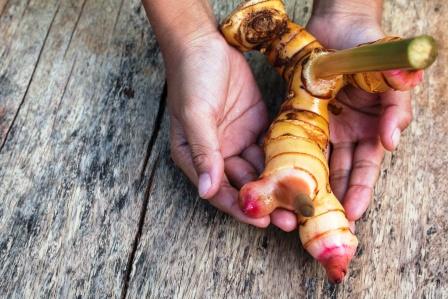
Chemical composition
Chemical composition of Alpinia galanga:
Major constituents of the essential oil, which is obtained from the plant, are methyl cinnamate, cineole and d-pinene. Three flavonoids- Alpin, Galangin and Kaempferide are also found in the plant.
The rhizomes are rich with phlobaphanes, galangol, kaempferide, galangin, bassorin, gadenens, cineole-d-pinene, eugenol etc chemical constituents.
Uses, Sanskrit verse
Uses of Thai Ginger – Mahabhari vacha:
- 2-3 g of powder is added with a glass of buttermilk or hot water and consumed to improve the appetite and treat cases of indigestion.
- The powder of the rhizome of Mahabhari vacha is rubbed slightly over the penile region in cases of erectile dysfunction and lack of libido in males.
- Small piece of rhizome is kept in the mouth and chewed slowly in conditions of bad odor of mouth, sore throat and hoarseness of the voice.
- The powder of the rhizome is rubbed all over the body in case of hypothermia, to increase the peripheral circulation and increase the body temperature.
- 2-3 g of powder is added with a glass of buttermilk or hot water and consumed to improve the appetite and treat case of indigestion.
- The powder is added with hot water and made into paste and this is applied over the joints having inflammation and pain.
- To decrease the quantity of urine output, the powder or decoction of the rhizome of Alpinia galanga is consumed.

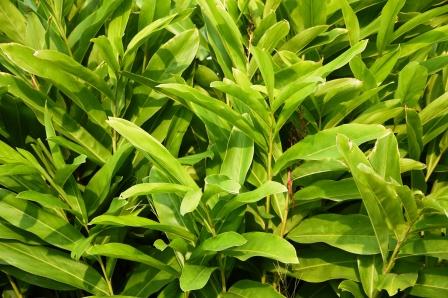
Interaction with medicines, supplements
Can this be used while taking Homeopathic medicine?
Yes. This product does not react with homeopathic medicine.
Can this medicine be continued while taking supplements like multivitamin tablets, Omega 3 fatty acids etc?
Yes. Generally, this product goes well with most dietary supplements. However, if you are taking more than one product per day, please consult your doctor for an opinion.
With western
medicines
Seek your
doctor’s advice if you are taking this product along with other western
(allopathic / modern) medicines. Some Ayurvedic herbs can interact with modern
medicine.
If both Ayurvedic and allopathic medicines are advised together, then it is
best to take Allopathic medicine first, wait for 30 minutes and then take the
Ayurvedic medicine.
Sanskrit synonyms
Sanskrit Synonyms of Kulanjan:
Sthoola granthi- Have big rhizome
Sugandha, Gandha moola, Ugra gandha- Rhizome have good, strong aroma
Elaparni- Leaf resembles to the leaf of cardamom plant
Rakta pushpa- Flowers are red in color
Kapidruma, Malaya Vacha, Koraj, Sthulagranthi, Nakuli, patala, Elaparni, Gandha Varuni
Morphology
Morphology of Alpinia galanga:
It is a small plant growing to a height of 1.5-2 m. The stem is leafy like that of Vacha (Acorus calamus). The leaves are 1-2 feet long and 4-6 inch wide, green and soft. The flowers are seen in clusters, 1-2 feet long, having hair like structures and greenish white in color. They are seen in the summer season. The fruits are round, reddish inside and have a smell like that of cardamom. Seeds are pale brown, flat and slightly triangular in shape and have a strong odor. The rhizome of the plant is thick and can grow up-to 1 foot long and 2 inch thick and has a pleasant, strong odor like that of pepper.
Ayurvedic medicines
Ayurvedic medicine containing Mahabhari vacha:
P-Kof-syrup: This is a proprietary ayurvedic cough syrup which is beneficial for the treatment of cough, asthma and allergic conditions.
Research
Research articles related to Alpinia galanga:
Anti- melanoma activity:Two compounds, 1,7-bis(4-hydroxyphenyl)-1,4,6-heptatrien-3-one (BHPHTO) and bisdemethoxycurcumin (BDMC) they have been isolated from the rhizomes of Alpinia galangal, and the structures of both pure constituents were determined using spectroscopic analyses. The study examined the bio effectiveness of the two compounds on the human melanoma A2058 and showed that significantly inhibited the proliferation of melanoma cells in the cell viability assay.
Anti- microbial activity: The present study was carried out to determine antimicrobial and radical scavenging effect of leaf and rhizome extract of A. galanga. The powdered leaf and rhizome were extracted by soxhlet extraction using methanol. Antimicrobial activity of extracts was determined by Agar well diffusion assay against 15 clinical isolates of bacteria (from burn, dental caries and urinary tract infection) and two fungi (Candida albicansand Cryptococcus neoformans). Rhizome extract was found to possess high inhibitory activity against fungi and clinical isolates of bacteria. The plant can be used for the development of agents active against pathogenic microbes and radical induced damage.
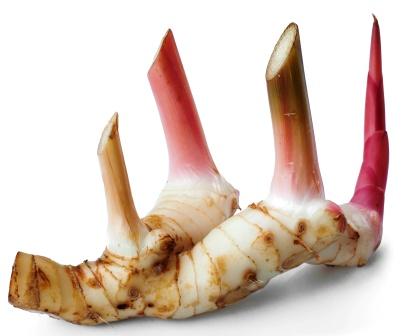
Action against gastric cancer cells: This study evaluated the effect of Alpinia galangal on AGS cells (human gastric adenocarcinoma epithelial cell line) and L929 cells (as a standard cell line originated from mouse fibroblast cells). After culturing the cells in Roswell Park Memorial Institute (RPMI) medium, the cells were incubated with different doses of Alpinia galangal (0 (control), 125, 250, 500, 750 and 1000 µg/ml) in 24, 48 and 72 hour periods and then, cells viability were assessed using MTT based cell proliferation assay. After 24 hours, the percentage of living AGS cells compared to the control group showed no significant decrease at the concentrations of 125 and 250µg/ml. But in the rest concentrations were significant (p<0.05). We have demonstrated, using the cell culture model, the anti-proliferative effect of aqueous extract of Alpinia galangal on human gastric tumor (AGS) and L929 cell lines. This effect was prominent in high concentrations
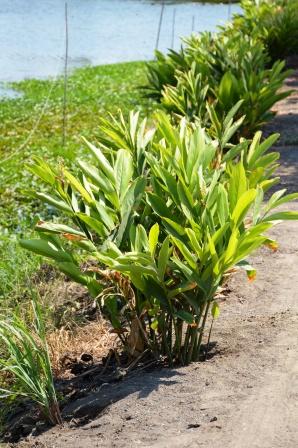
Classical categorization
Bhavaprakasha- Hareetakyadi Varga
Raja Nighantu- Pippalyadi Varga
Priya Nighantu – Shatapushpadi Varga
Scientific classification
Kingdom: Plantae
Order: Zingiberales
Family: Zingiberaceae
Subfamily: Alpinioideae
Tribe: Alpinieae
Genus: Alpinia
Species: A. galanga
Vernacular names
Names in different languages:
Hindi name- Kulanjan
English name- Java galangal, Greater galangal, Blue ginger, Thai ginger, Siamese ginger
Bengali name- Barakalinjan
Gujarati name- Kolinjan
Kannada name- Doddarasa Gadde
Malayalam name- Aratta
Marathi name- Koshthkulinjan
Tamil name- Aruttai
Telugu name- Dumpara stramu
Urdu name- Kulanjan
Arabic name – Khalanjan, Khulanjan – e – kabir
Chinese name – Liyang – chiang
Burmese name – Padagoji
Deccan name – Barakhulanjan
Malay name – Launcher
Persian name – Khurduwari
Portuguese – Galanga
Sindh name – Kathi
Urdu name – Kuknjan
History
History
It was probably brought to India in the 12th AD. Shodhala quoted Kalinjanadi avaleha in Gada Nigraha. Bhavamisra (16 AD ) described two varieties Mahabharivacha and sthulagranthi vaca. The former is pungent in smell while the latter has aroma. Raja nighantu described it as kulanjan whereas no mention is made in Dhanvanthari Nighantu.
Author: Dr.B.K.Prashanth M.D (Ayu), Ph.D
E mail: [email protected]
Click to consult Dr Prashanth BK
Home remedies
Kulinjan (Alpinia galanga) Remedies by Dr MS Krishnamurthy:
Kulinjana or Mahabhari vacha is most commonly used in oral healthcare, headache and bodyache.
Botanical name – Alpinia galanga Willd. Languas galanga and it belongs to the family Zingiberaceae. It is called Greater galanga, Thai ginger, Blue ginger in English.
As per the Ayurvedic literature the plant is appreciated for its diaphoretic, stimulant, expectorant, digestive, carminative, anti flatulent, tonic and aphrodisiac properties. It is used while treating the cough, asthma, hoarseness of the voice, cold, fluetc.
Greater galangal is used as a substitute for Choapachini (China roots).
Following are few of its simple and effective health recipes-
Cough, cold, asthma
1. Fine powder of Kulanjan with honey for cough, cold and asthma:
The dried rhizomes are made into fine powder and mixed with honey. It is taken by licking. This is effective in cough, cold and asthma.
Excessive perspiration
2. Fine powder with Sariva (Hemidesmus indicus) for excess perspiration and bad odor of the body:
Sariva and Kulinjana are taken in 2:1 ratio and fine powder is made. This is mixed with rose water and fine paste is obtained. This paste is applied all over the body 30 minutes prior to taking the bath. This is very effective in bad body odor.
Toothache
3. Fine powder or small piece of Greater Galangal in tooth ache:
The fine powder of the rhizome or a small piece of the drug is taken and retained in the mouth or else the powder is rubbed to the gums in case of toothache. This effectively manages the mild toothache.
Bad breath
6. Chewing Alpinia galanga for bad breath:
Small piece of the rhizome is chewed regularly, immediately after the food intake. This is good in bad breath conditions.
Joint pain, body ache
5. Oil of the rhizomes of Kulinjan for joint pain and bodyache:
Traditional oil is prepared by adding the fine paste of the drug, oil and decoction of the drug. This oil is effective in joint pains and muscular pain including the generalized body ache. Especially in the body pain caused during the winter season it is very effective.
Alpinia officinarum Hance. is also used in the place of Kulinjan with lesser effects. Tribal people process Kulinjana with cow’s urine so as to make it apt to use while treating Rheumatoid arthritis and other joint disorders. Cultivation of Kulinjan can be made as an economic source for the agriculturists and NGOs and Government can take initiation in this regard.
Click to consult Dr MS Krishnamurthy MD(Ayu), PhD.
Systemic Action
Externally – External application of its paste helps to relieve cold. Have scraping action.
Internally – Nervous system – Act as a nervous tonic, Stimulant. Indicated in nerve degenerative conditions, diseases due to imbalanced vata dosha
Digestive system – It is spicy in taste, carminative, digestive and facilitate movement of doshas in proper direction. Overdose can cause stomach disturbances, causes aggravation of pitta dosha, Stimulates salivary secretion. Cleanses mouth. Indicated in Anorexia, low digestive power, abdominal cramp etc.
Circulatory System – Slow down the activity of Heart, Indicated in vatika Hridroga
Respiratory System – Balances kapha dosha. Indicated in cough, breathing difficulties and in hoarseness of voice. Act as a Bronchodilator, Strengthens vocal code
Excretory system – Reduces urine production, Indicated in polyurea, Diabetes etc.
Reproductive System – Stimulate uterine contraction. Aphrodisiac, indicated in impotency conditions.
Skin – Provide warmth for the body. Indicated in cold climate






